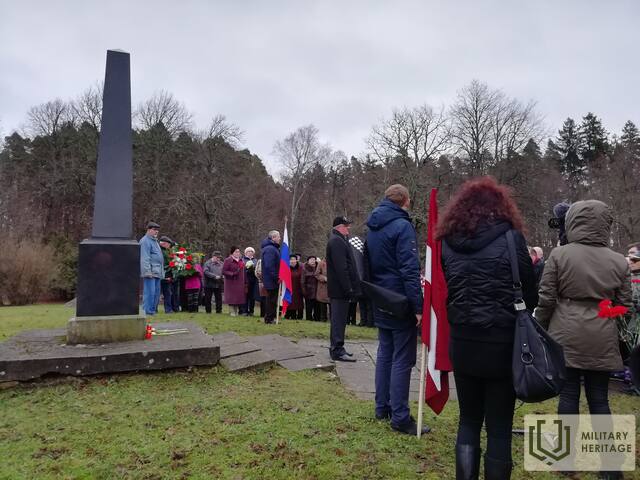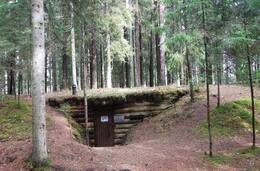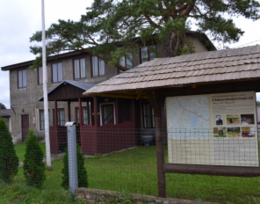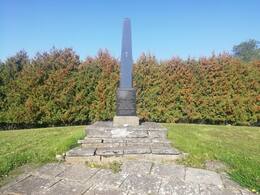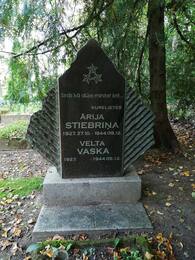Zlėkų tragedijos vieta Latvijos istorijoje vis dar neaiški
Antrojo pasaulinio karo metais, kai didžiąją Latvijos dalį jau valdė Sovietų Sąjunga, o Kuržemę valdė Hitlerio Vokietijos vicekaraliai, Kuržemėje vadinamieji kureliečiai pradėjo kovą dėl Latvijos valstybinės nepriklausomybės atkūrimo.
Beviltiškas ir idealistinis Kurelų leitenanto Roberto Rubenio bataliono karinis pasipriešinimas vokiečių 16-osios armijos dalims, SD ir SS daliniams truko nuo 1944 m. lapkričio 14 d. iki gruodžio 9 d. Ugalės, Usmos, Rendos ir Zlėkų valsčiuose ir baigėsi tragiškais įvykiais Ventspilio 9 ir 9 d.
Per šias dvi dienas, kovodami su tautiniais ir sovietiniais partizanais, vokiečiai nusprendė nubausti juos rėmusius vietos gyventojus – žemėlapyje nubrėžė ratą aplink Zlėkus ir juos apsupo. Visi viduje buvę žmonės žuvo, o pažymėtoje vietoje sudegė visi aštuoni namai. Dauguma nužudytųjų buvo pabėgėliai iš visiškai skirtingų Latvijos vietų, daugelis jų atvyko visai neseniai.
Apie tai, ar dar pakankamai nesupratome ir neįvertinome Zlėkų tragedijos reikšmės Latvijos valstybės istorijoje – pokalbis su fiziku Oļģertu Lielausu, Latvijos mokslų akademijos nariu. Jis vadovavo prieš dešimt metų įsteigtai Latvijos mokslų akademijos iniciatyvinei grupei, kurios užduotis buvo išsaugoti istorijai ir tautinei atminčiai ryškiausius Latvijos pasipriešinimo judėjimo Antrojo pasaulinio karo metais ir jo aukų įrodymus.
1944 m. gruodį Lielausui buvo 14 metų ir trys mėnesiai ir jis vis dar gali papasakoti apie tai, kas tuo metu vyko, taip pat prisimena keletą ryškių epizodų.
"[Rubenio bataliono] pėstininkai ėjo palei Abavą, bet vežikai ėjo per Cirkalę. Ten buvo kelias. Atsimenu, Cirkalė buvo pilna pabėgėlių. Kariai įėjo į didelį pastatą, kurio jau nebėra. Jie domėjosi, kokius ginklus turi vokiečiai. Ar jie turi pėstininkų ar kitokių ginklų? Žmonės kalbėjo, kad Rubenistį veža sužeistas.
Prie Cirkalės stovi [vokiečių 1944 m. gruodžio 7–10 d. sudeginti] namai – „Grauči“. Šalia „Graučių“ yra „Jaunarāji“, kur gyveno mano giminės, visi buvo sušaudyti. Iš viso sudegė aštuoni namai. Esą aukščiausias Vokietijos SS ir policijos pareigūnas Ostlande Jekelnas žemėlapyje nubrėžė dar didesnį apskritimą, įskaitant Cirkalį, kur turėjo būti įvykdyta bausmė, tačiau tai buvo užprotestuota.
Didžiausia neteisybė ta, kad čia buvo sušaudyta apie 160 žmonių. Dažniausiai visi kalba apie karių didvyriškumą, bet kaip tai sieti su tragiškumu? Net Mokslų akademija įsteigė specialią komisiją Zlėkų tragedijos įrodymams išsaugoti istorijai, tačiau šis reikalas merdėjo ir iki šiol nebuvo įmanoma jo rimtai pajudinti.
Karo keistenybės ir įdomybės
Paklaustas, ar tai buvo didžiausias mūšis, kur latviai labai rimtai susirėmė su vokiečiais, Lielaus atkreipia dėmesį, kad toje vietovėje nebuvo nė vieno vokiečio. "Prie Abrinių, anapus Abavos, rusiškai keikėsi, nes ten buvo vlasovičių, o šitoje pusėje - latgaliai. Tuo metu buvo madinga drąsiausiems vyrams šaudyti iš peties sunkiuoju rusišku kulkosvaidžiu "Maxim". Ir vienas iš jų, latgalis, šaudamas rusiškai keikėsi, o iš kito banko irgi pasigirdo keiksmai."
"Cirkalėje gyveno mano krikšto mama su vyru miškininku. Pas juos nakvojau vasarą. Cirkalėje buvo dislokuotas vokiečių "Jagdverband" dalinys, kuris buvo pavaldus SD. Jame buvo apie 40-50 žmonių, bet vokiečių tarp jų praktiškai nebuvo, bet buvo vengrai, totoriai. Vokiečių dalinys, juos globojo ] Prisimenu epizodą, kai viename tvarte dideliame katile vaikėsi kandis, nes kareiviai prisigėrė prieš eidami į mišką, ir taip buvo iš abiejų pusių.
Kitas epizodas – Cirkalėje, kur buvo įsikūręs vokiečių dalinys, du latvių kariai buvo sugauti ir uždaryti dideliame tvarte. Juos saugojo ir latviai. Prisimenu, vienas iš jų pasakė: „Jansonai, eik ir pasakyk Fritams, kad vienas iš jų susprogdino“. Prižiūrėtojai nustatė, kad langų grotos buvo perstumtos ir vienas iš sulaikytųjų – įsilaužėlis – pabėgo, tačiau kitas sulaikytasis turėjo atostogų pažymėjimą, kuris buvo laikomas saugiu dokumentu ir nors galėjo pabėgti, tačiau to nepadarė.
Atvyko sargybos viršininkas unteršarfiureris, austras, kuris buvo gražus vaikinas ir labai populiarus tarp dukterų. Jis išėjo ir sumaištyje, civilių pabėgėlių akivaizdoje, nušovė nepabėgusį suimtąjį su atostogomis. Sumišimas išliko dar didesnis, šaulys buvo sutrikęs dėl nelaimingo atsitikimo jo sargybos pamainoje, visi susirinkę buvo sutrikę. Vokiečiai tuoj pat išsivežė nušautą...
Kitas epizodas „Cirkale“ – mano tėvas sureguliavo radiją, kad galėtų klausytis anglų kalbos žinių. Kartą jis klausėsi jų kambaryje ir už jo įėjo vokiečių vadas. Tėvas manė, kad bus didelė netvarka, bet ne, vokietis guodėsi ir paklausė, kur dabar frontas Vakaruose. Jis turėjo šeimą kažkur Vokietijoje ir domėjosi, ar ten atvyko anglai, prancūzai ar amerikiečiai.
Situacija buvo tokia, kad net vokiečiai nežinojo, kas vyksta jų namuose. Tuo metu tai buvo Cirkalėje.
Zlėkų tragedijos memorialas
"Rusijos laikais buvo priimta: kiekviena respublika turėjo turėti aukštybinį pastatą, mes turime Mokslų akademiją, ir buvo priimta: kiekvienai respublikai, kaip taisyklė, reikia vokiečių avarinių darbų. Baltarusijoje, Ukrainoje gali turėti kiek nori, bet mes jų neturėjome, tik Audrinėse."
Dar visai neseniai Mokslų akademijoje ginčydavomės, kad didžiausias karo nusikaltimas Latvijos teritorijoje įvykdytas Zlėkose, kuris iki šiol buvo užmirštas. Zlėkų tragedijos bylą sovietmečiu tyrė akademikas Vilis Samsonas, pats kovojęs sovietų partizanuose.
Paskutiniais karo etapais daug Zlėkų parapijos gyventojų teikė pagalbą sovietų partizanams ir žvalgybininkams, rėmė vokiečių fašistinės armijos dezertyrus. Įtūžusi nesėkminga kova su partizanais, generolo Friedricho Jeckelno vadovaujama baudžiamoji ekspedicija žiauriai atkeršijo vietos gyventojams.
Bet sovietiniai partizanai Jekelnos nesupykdė – „Raudonoji strėlė“ sėdėjo krūmuose prie Zlėkų ir stebėjo, kas vyksta. „Jekelną įsiutino kureliečių kova ir rubeniečių karinis pasipriešinimas, o gyvybe už tai sumokėjo apie 160 nekaltų žmonių – tiek didelių, tiek mažų – tiek vietinių, tiek pabėgėlių, išbuvusių karinėje zonoje gerokai ilgiau nei savaitę.
Šiandien Zlėkuose yra kartuvių kalnas. Dalis nužudytųjų ten perlaidoti. Apytiksliai dvidešimt riedulių su nužudytųjų vardais sudaro apskritimą, o centre – maždaug trijų metrų aukščio juodo marmuro obeliskas. Manoma, kad jis paimtas iš senųjų „žydų kapinių“ Maskvos priemiestyje Rygoje.
Ar ne laikas jį grąžinti ir vietoje jo įrengti latvišką riedulį su šios dienos užrašu ir kryžiaus ženklu? Manau, kad Zlėkų tragedijos aukoms reikia pagerbti, o simbolinė vieta šiai pagerbimui būtų Zlėkų Karvių kalnas. „Už kureliečių kovą už Latvijos nepriklausomybės atkūrimą buvo sunaikinta 160 žmonių, o šie kovotojai neprilygo nei vokiečių, nei sovietų okupacinei valdžiai.
Delfi (2014.11.12.) Praėjo 70 metų nuo Zlėkų tragedijos; jos vieta Latvijos istorijoje vis dar neaiški . Prieiga: https://bit.ly/3sj6Sdp
Susijusi laiko juosta
Susijusios vietos
Rubenio bataliono bunkeris ir mūšio laukai
Restauruotas Rubenio bataliono 2-osios kuopos žeminė yra miške prie Ilziki ežero Usmos valsčiuje. Žeminę galima apžiūrėti iš išorės nemokamai bet kuriuo metu. Tačiau ekskursijas žeminės viduje būtina užsisakyti iš anksto.
Leitenanto Roberto Rubenio batalionas buvo generolo Jānio Kurelio suformuoto karinio dalinio dalis ir žinomas dėl to, kad nepasidavė vokiečių kariuomenei ir demonstravo didelį pasipriešinimą. 1944 m. lapkričio 14–gruodžio 9 d. Ugalės, Usmos, Rendos ir Zlėkų valsčiuose vyko įnirtingi mūšiai tarp 16-osios Vokietijos armijos, SD ir SS dalinių, vadovaujamų policijos generolo Friedricho Jeckelio, ir Kureliečių dalinio bataliono, vadovaujamo leitenanto Roberto Rubenio. Rubenio vadovaujami vyrai buvo gerai ginkluoti ir organizuoti, nesiejo savęs su jokia iš dviejų priešiškų okupacinių jėgų. Jų veiksmai laikomi plačiausiais ir ilgiausiais Latvijos nacionalinio pasipriešinimo judėjimo istorijoje. Mūšiuose prie Rendos ir Zlėkų žuvo apie 250 vokiečių kareivių, o Rubenio vyrai patyrė tik 50 aukų. Tų dienų įvykius simbolizuoja miške atkurta žeminė (velėna dengta, žemėje iškasta rąstinė trobelė), kurioje kadaise buvo apsistoję Rubenio bataliono vyrai.
Rubenis' battalion museum
Rubenis’ Battalion Museum is located in Ugāle. It is dedicated to the Battalion of R. Rubenis, who served and fought under General J. Kurelis in Kurzeme in 1944, the activities of the Kurelians and the national resistance movement. Museum has an exhibit on the activities of the Latvian Central Council (LCC) and its Ventspils group, as well as the LCC Memorandum with 188 signatures and photographs of signatories that is included in the Latvian National Register of the UNESCO Memory of the World Programme. The LCC was a joint centre of Latvia's highest political leadership with an underground government that operated during the occupation of Latvia from 1943 to 1994. It was formed with the aim of coordinating the activities of various Latvian resistance movements in order to restore Latvia's national independence. The museum also offers a trip to places significant to the history of the battalion (settlement with a reconstructed bunker in the Usma parish, battlefields in Renda and Zlēkas parishes, etc.).
Zlēku Tragedy Memorial Site
The memorial is located near the Zlēki Manor ensemble, in the western part of Karātavkalns. Around twenty boulders with the names of the people killed form a circle, and in the centre is a black marble obelisk about three metres high.
Some of those killed have been reburied at the Zlēki memorial.
In December 1944, in the vicinity of Zlēki, the German Nazi army carried out a large-scale operation against the civilian population.In the combat action log of Army Group Nord, an entry was made at 17.30 on 9 December 1944 that 161 people belonging to the "Rubens Brigade and units of the Red Arrow" had been killed on the enemy side during the action. In Soviet times, this figure was apparently taken as the total number of victims of the Zlēki tragedy, referring to civilians killed.
The course of the action is partly documented in the report of the head of the counter-intelligence section of the German 16th Army of 31 December 1944. It explains that from 5 to 9 December, under the leadership of the highest SS and police leader in Ostland, SS Oberruppenführer and Police General Friedrich Jekeln, a large-scale operation took place at Eichensumpf ("Oak Swamp") against the "Red Arrows" and the remnants of General Kurel's group at Abava.
Monument to the paramedics of Ruben's battalion
Ārija Stiebriņa and Velta Vaska, paramedics of the Rubeņa battalion, were reburied in the Cirkale cemetery, who were shot by German Nazi army units on December 9, 1944, together with other residents, deserters, etc. captured in the vicinity of Zlēki.
According to the stories, it follows that the young women have joined Ruben's battalion voluntarily. Together with Ruben's battalion, they went from Suntaži to Usma. However, during the Jekelna campaign, the young women were arrested on the road, taken to the forester's house in Vēlogi for questioning and shot together with a small group of other detainees. A woman, a resident of Cirkale, knew Arya and managed to rebury the remains of both girls at the edge of the Cirkale cemetery and took care of this cemetery throughout the Soviet occupation.
Under the leadership of SS-Obergruppenführer and General of Police Friedrich Jäckeln, head of the German 16th Army's counter-intelligence division, the top SS and police chief in Ostland, a large-scale operation took place in the Eichensumpf ("Oak Swamp") from December 5 to 9, which was directed against the "Red Arrow" and General The remnants of the Kurelis group near Abava.
The progress of the action is partially documented in the report of December 31, 1944.




